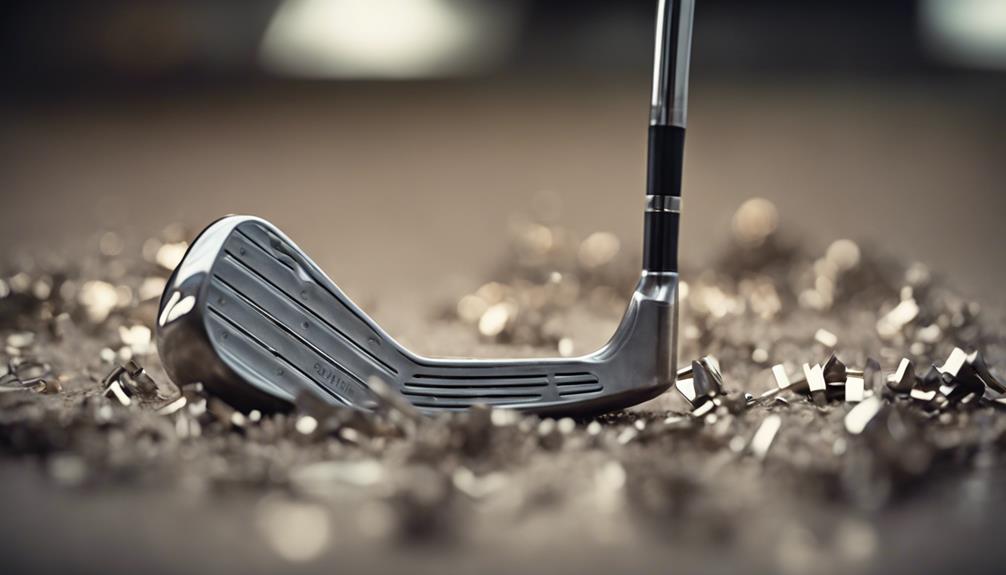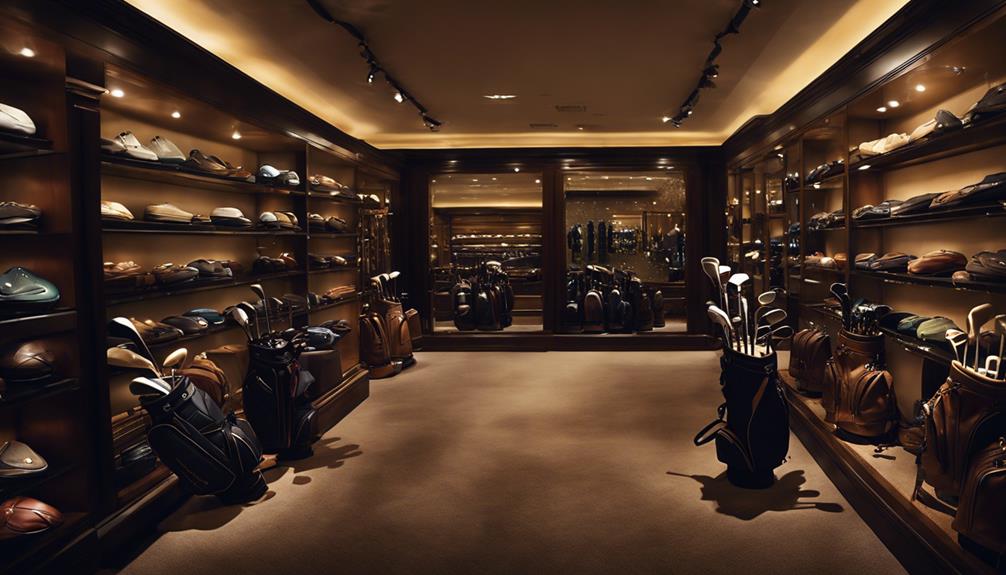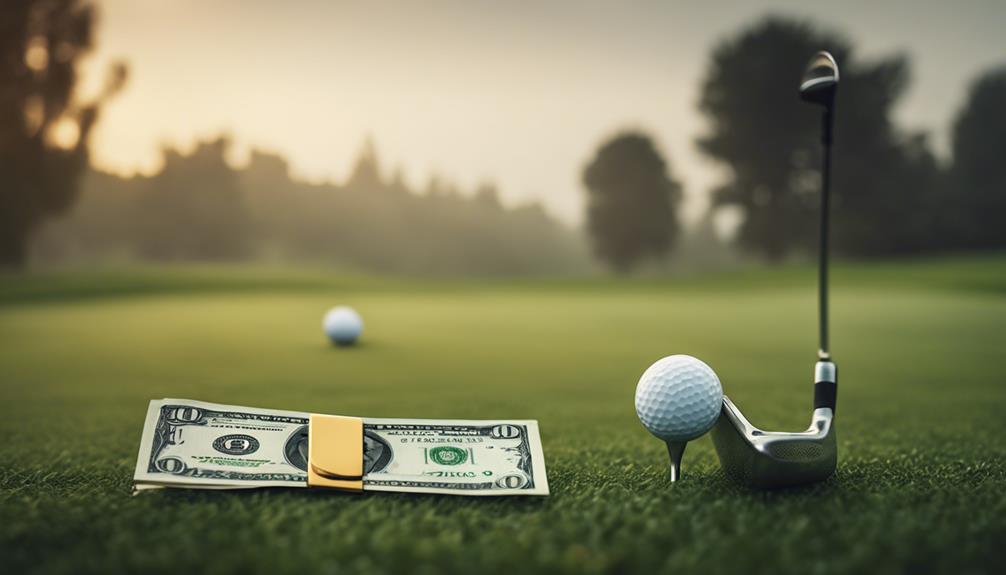- 7 Top Flite Golf Clubs XL for Improved Performance - September 28, 2024
- Top Flite Golf Clubs: Top 5 Reasons to Choose Them - September 28, 2024
- Top 3 Golf Club Fitters for a Perfect Swing - September 28, 2024
You've likely wondered why golf clubs can cost thousands of dollars, and it's not just because they're fancy sticks used by wealthy professionals. Several factors contribute to their high price tags, including the use of premium materials like titanium and graphite, complex manufacturing processes, and significant investments in research and development. Brand reputation, marketing strategies, and precision craftsmanship also play a role. Additionally, the psychology of premium pricing and the perceived value of exclusive brands influence consumer demand. As you explore the world of golf clubs, you'll uncover more nuances that justify their hefty price points – and discover what makes them worth the investment.
Key Takeaways
- Golf clubs can be expensive due to the use of premium materials like titanium and graphite, which increase production costs by 50%-100% compared to steel.
- Research and development costs, including investments in cutting-edge technologies and expert designers, are factored into the final pricing of high-end golf clubs.
- Advanced manufacturing processes, such as computer simulations and AI-powered design tools, drive up costs but optimize club performance and aerodynamics.
- High-grade materials, precision craftsmanship, and custom-fitting contribute to the high prices of premium golf clubs, justifying their value through enhanced performance and durability.
Factors Influencing Golf Club Prices
When you're in the market for a new set of golf clubs, you'll likely notice that prices can vary wildly, and it's the factors influencing golf club prices that ultimately drive these costs up.
One significant contributor is the use of premium materials, such as titanium and graphite, which can increase production costs by 50%-100% compared to traditional steel. Golf club manufacturers that opt for these high-end materials do so to provide better performance, but it comes at a price.
Additionally, complex manufacturing processes that utilize advanced technology and engineering expertise also contribute to higher prices. These processes require substantial investment, which is then passed on to you, the consumer.
The Golf Clubs Cost is further inflated by the prestige and brand reputation of manufacturers, which can justify higher prices.
As you explore your options, keep in mind that these factors will impact your wallet. Understanding what drives the cost of golf clubs will help you make an informed decision when investing in your next set.
The Role of Research and Development
As you explore the reasons behind the high cost of premium golf clubs, you'll find that research and development (R&D) investments play a significant role.
You'll notice that top manufacturers pour a substantial amount of resources into cutting-edge technologies, such as AI and computer simulations, to optimize club performance.
These investments ultimately drive up the cost of premium clubs, making them more expensive than their lower-quality counterparts.
R&D Investments
You might be surprised to learn that the golf equipment industry invested approximately $4.7 billion in research and development in 2002, with a significant portion allocated to premium clubs that drive sales through enhanced performance. This substantial investment in R&D is a key factor in the higher cost of premium golf clubs.
To create innovative designs, manufacturers hire experts, utilize advanced computer simulations, and conduct extensive testing. This process involves collaboration between chemists, mathematicians, and PGA professionals to guarantee continuous innovation in club design, materials, and manufacturing processes.
The costs associated with R&D are factored into the final pricing of high-end golf clubs, justifying their higher price points. Here are some key aspects of R&D investments:
- Hiring product engineers, designers, and material experts to create innovative designs
- Utilizing advanced computer simulations to perfect club performance
- Conducting extensive testing, including live testing facilities, to guarantee peak results
These investments in R&D contribute to the overall expense of premium golf equipment, making them more expensive than their lower-end counterparts.
Cutting-Edge Technology
By harnessing cutting-edge technology, golf manufacturers can craft premium clubs that boast exceptional aerodynamics, precision, and performance, ultimately justifying their higher price points. You might wonder how this technology contributes to the cost of golf clubs. The answer lies in the significant investments made in research and development (R&D).
| Technology | Benefit | Impact on Price |
|---|---|---|
| Advanced Computer Simulations | Optimized club design for aerodynamics and performance | Increased manufacturing costs |
| Innovative Club Designs | Enhanced club performance and features | Higher material and production costs |
| AI-powered Design Tools | Streamlined design process, reduced prototyping time | Reduced costs, but still significant investment |
| Materials Science Advancements | Lightweight, durable, and high-performance materials | Higher material costs |
| Virtual Prototyping | Reduced physical prototyping, increased design iterations | Reduced costs, but still significant investment |
These cutting-edge technologies, along with R&D efforts, drive up the cost of premium golf clubs. Manufacturers pass on these costs to consumers, resulting in higher price points for clubs that offer exceptional performance and features. By understanding the role of cutting-edge technology in golf club manufacturing, you can appreciate the value behind the premium prices.
Material Costs and Quality Control

Premium golf clubs' hefty price tags are largely attributed to the meticulous selection of high-quality materials and rigorous quality control measures employed during their production. As you explore the world of high-end golf clubs, you'll notice that manufacturers spare no expense in sourcing the finest materials to craft exceptional clubs.
Some key factors contributing to the elevated material costs and quality control measures include:
- High-grade stainless steel, titanium alloy, and carbon fiber materials that increase production costs
- Graphite shafts, which are 50% to 100% more expensive than steel shafts, enhancing flexibility and control
- Forged clubs undergo a more complex manufacturing process, increasing machine time and tooling costs
These factors all play a significant role in driving up the cost of premium golf clubs. By understanding the attention to detail and rigorous testing that goes into each club, you'll appreciate the value behind the hefty price tag.
Manufacturing Complexity and Expertise
As you explore the world of high-end golf clubs, you'll notice that manufacturers integrate advanced components, select premium materials, and employ skilled craftsmen to create precision instruments.
This trifecta of complexity, expertise, and attention to detail drives up production costs, making these clubs a significant investment.
High-Tech Component Integration
When you consider the cost of golf clubs, you might wonder what drives the prices up. Frequently, golf club manufacturers rely on advanced computer simulations and AI to precision-craft club designs and aerodynamics, considerably driving up production costs. This integration of high-tech components is a significant contributor to the expense of golf equipment.
To develop clubs that cater to specific performance demands, manufacturers invest in research and development, employing product engineers, designers, and material experts. This expertise comes at a cost, which is reflected in the final price of the clubs. Additionally, the use of sophisticated materials and specialized manufacturing processes adds to the complexity and expense of producing high-end clubs.
Some key factors contributing to the high cost of golf clubs include:
- Advanced computer simulations and AI for precision design
- Investment in research and development for innovative club designs
- Use of sophisticated materials requiring specialized manufacturing processes
Advanced Material Selection
You're likely familiar with the idea that the right materials can make all the difference in a golf club's performance, and manufacturers spare no expense in selecting the best ones for their high-end clubs.
Advanced materials like titanium alloy, carbon fiber, and high-grade stainless steel are chosen for their unique performance benefits, but they considerably increase production costs. Graphite shafts, for instance, can cost 50%-100% more than steel alternatives, contributing to the overall expense of high-end clubs.
The manufacturing process for premium clubs involves complex techniques and engineering expertise to guarantee peak strength, weight distribution, and forgiveness in clubhead designs, which elevates costs. High-quality materials undergo rigorous quality control and are meticulously selected for their specific characteristics, further driving up the price of premium golf clubs.
The use of advanced materials, combined with precise manufacturing techniques, results in high-performance clubs that come with a hefty price tag. As you consider investing in a premium golf club, remember that the advanced materials and expertise that go into its creation are major factors in determining its price.
Precision Craftsmanship Process
Frequently, the manufacture of premium golf clubs involves a painstakingly precise process, where advanced engineering techniques and AI-driven designs converge to create high-performance clubs that command a premium price.
This precision craftsmanship process is what sets premium clubs apart from their more affordable counterparts. When you opt for a high-end club, you're paying for the expertise and attention to detail that goes into crafting a better-quality product.
Some key aspects of this process include:
- The use of complex manufacturing techniques, such as forging or milling, which require more time and resources than simpler casting methods.
- The handcrafting of custom clubs in small batches, allowing for meticulous attention to detail and rigorous quality control.
- The selection of premium materials, such as titanium alloys and advanced composites, which enhance club performance but also raise manufacturing expenses.
Marketing Strategies and Brand Prestige

By leveraging celebrity endorsements and sponsorships, major golf brands create a perceived value that directly inflates the retail prices of their clubs, making them more desirable and expensive to consumers.
You might be surprised to learn that these marketing strategies greatly impact your wallet. The prestige associated with well-known golf brands, such as Callaway or TaylorMade, influences your purchasing decisions, leading you to pay premium prices for their clubs.
Brand loyalty plays a critical role in this process, as you often associate high prices with superior quality and performance. High-end golf clubs are frequently marketed as status symbols within the golfing community, further justifying elevated price points and enhancing their desirability among consumers.
Even the launch of limited-edition clubs and exclusive collaborations can lead to higher prices, as they often employ unique materials and advanced technologies. As a result, you're willing to pay more for these exclusive club heads, perpetuating the cycle of demand for costly products.
The Psychology of Premium Pricing
The golf industry's reliance on premium pricing strategies taps into consumers' subconscious desire for status and exclusivity, making them more willing to part with their hard-earned cash for high-end clubs. You might think it's just about the quality of the clubs, but it's also about the perceived value and prestige that comes with owning them.
Manufacturers use celebrity endorsements and marketing campaigns to create a sense of luxury and scarcity, justifying higher prices. You're more likely to prioritize brand names over affordability, even if it means breaking the bank. Limited availability and exclusivity are emphasized to drive demand and inflate prices. Affordable alternatives are often overlooked in favor of the status symbol that comes with high-end clubs.
As a consumer, you're not just buying a product – you're buying into a lifestyle. The golf industry's marketing strategies exploit this, using consumer psychology to their advantage. By understanding the psychology behind premium pricing, you can make more informed purchasing decisions that align with your needs and budget.
Finding Value in Golf Club Investments

So, do you really get what you pay for when investing in premium golf clubs, or are you simply paying for the prestige that comes with owning them?
When you invest in high-end clubs, you're not just buying a brand name – you're getting advanced engineering, high-quality materials, and custom fitting options that can notably enhance your game.
With premium golf clubs, you're more likely to see improvements in performance and durability, which can lead to better scores and a more enjoyable playing experience.
Plus, these clubs tend to hold their value well, making them a worthwhile investment if you plan to keep them in good condition. You can even sell them or trade them in for newer models, recouping some of your initial investment.
And let's not forget about the long-term savings – premium clubs may require fewer replacements, saving you money in the long run.
When you consider the benefits, it's clear that premium golf clubs are worth the investment for serious golfers.
Frequently Asked Questions
Why Is Golf Such an Expensive Sport?
You'll find that golf's high cost stems from equipment costs for premium gear, course maintenance expenses, and membership fees, which are often justified by brand reputation, ultimately making it an expensive sport to participate in.
How Expensive Is Tiger Woods Golf Clubs?
"You think you're splurging on golf clubs? Tiger Woods' custom TaylorMade SIM2 driver alone costs around $600, and his full set can exceed $4,000 due to premium materials and cutting-edge technology, making his equipment a true investment in mastery."
Why Are Green Fees so Expensive?
You're wondering why green fees are so steep? It's because courses factor in green maintenance costs, luxurious course amenities pricing, seasonal pricing strategies, and membership fee structures, making your round of golf a premium experience.
Conclusion
As you weigh the cost of your next golf club purchase, remember that you're not just buying a stick with a fancy head – you're investing in a precision instrument crafted from cutting-edge materials, backed by research, and infused with expertise.
The price tag may sting, but it's a reflection of the art and science that goes into creating a tool that can elevate your game.
So, take a deep breath, swing for the fences, and remember: you get what you pay for.




